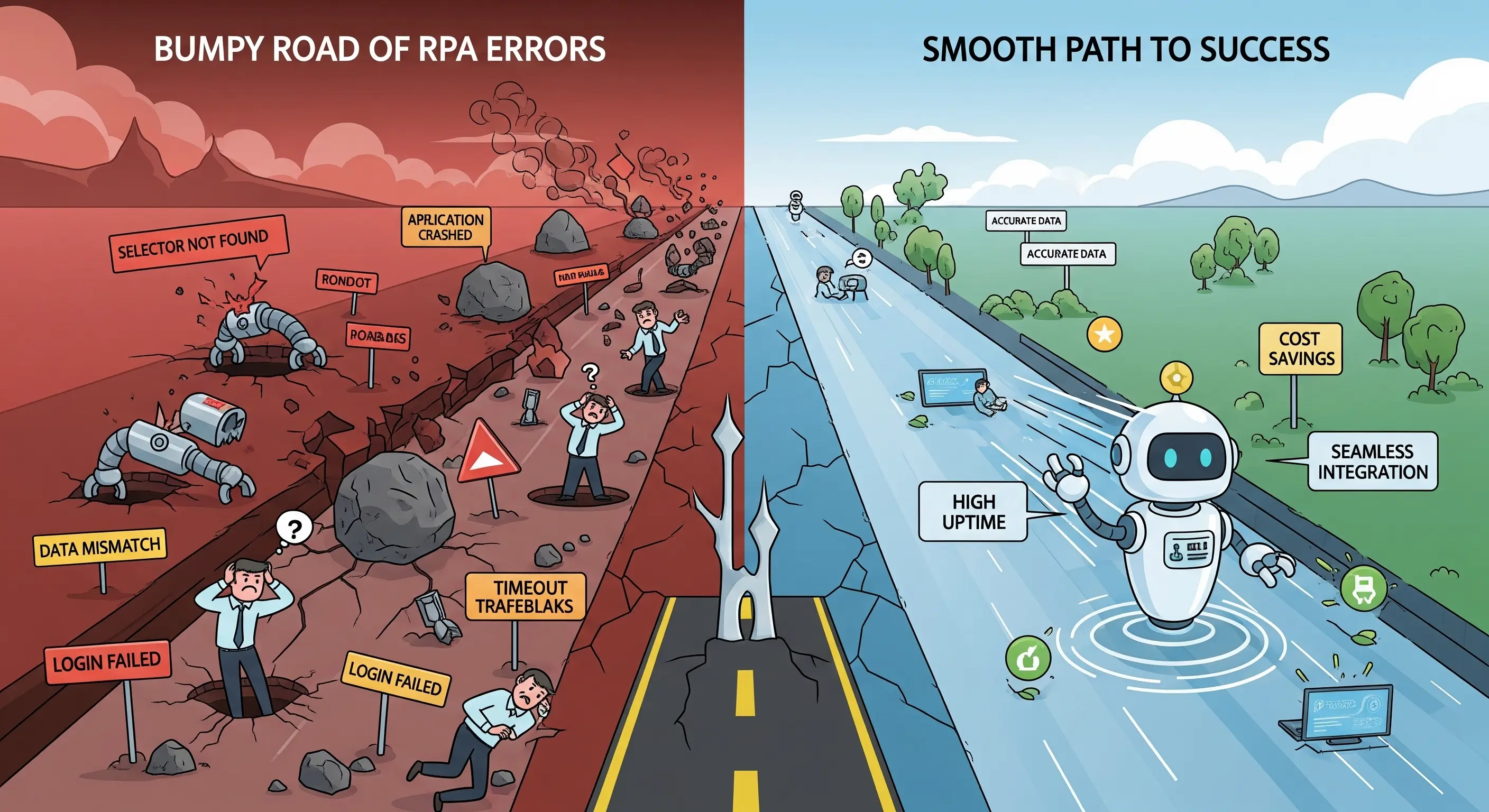Robotic Process Automation (RPA) promises to revolutionize operational efficiency, but making certain RPA implementation mistakes can steer a project away from success. While the technology is powerful, a flawed strategy often leads to RPA project issues, preventing the expected return on investment (ROI) from ever materializing.
The good news is that these obstacles are predictable and avoidable. By understanding the most common pitfalls and adopting a strategic approach, you can ensure your automation initiative not only takes off but also scales and transforms your business.
The RPA Paradox: High Expectations vs. Failure Risk
The excitement around RPA is justified, but it must be managed with realism. Various industry studies reveal a sobering truth. According to analyst reports from firms like Ernst & Young, between 30% and 50% of initial RPA projects fail to meet their objectives (CMSWire, 2019).
This RPA implementation failure is rarely due to the technology itself but rather to shortcomings in planning, process selection, and change management. Below, we break down the 7 most critical mistakes and explain how a no-code platform like STELA helps you overcome them.
1. Mistake: Choosing the Wrong Process to Automate
Not all processes are good candidates for RPA. Attempting to automate highly complex, non-standardized tasks that require constant human judgment and decision-making is a recipe for disaster.
Solution: Start with quick wins. Identify processes that are:
- Repetitive and manual: Such as data entry or invoice reconciliation.
- Based on clear rules: With little to no ambiguity in the steps.
- High-volume: So the impact of automation is significant.
2. Mistake: Lack of Alignment Between Business and IT
When RPA projects are driven exclusively by the business side without involving IT (or vice versa), silos emerge. IT may worry about security and infrastructure, while business focuses on agility. This disconnect creates friction and delays implementations.
Solution: Foster collaboration from day one. Creating a Center of Excellence (CoE) with members from both departments ensures that technical and business decisions are aligned and that clear governance standards are established.
3. Mistake: Underestimating Change Management
Employees may view “robots” as a threat to their jobs. This resistance, if unmanaged, can sabotage the adoption of the technology, no matter how good it is.
Solution: Communicate transparently. Frame the message that RPA is a “digital assistant” that eliminates tedious tasks, allowing the team to focus on higher-value activities. Offer upskilling so employees can learn to work alongside bots and even create them.
4. Mistake: Ignoring Scalability from the Start
Building your first robot might seem simple, but what happens when you have 10, 50, or 100? Without an architecture designed for growth, management, monitoring, and maintenance become chaotic, preventing automation from scaling across the organization.
Solution: Choose a platform built to scale. STELA offers a centralized orchestrator that allows you to manage the entire lifecycle of your robots—from development to execution and monitoring—ensuring orderly growth.
5. Mistake: Using Code-Based Tools for Simple Tasks
Traditional RPA platforms that require advanced programming create a heavy dependency on specialized developers. This leads to bottlenecks, increases costs, and slows down the delivery of value to business areas.
Solution: Adopt a no-code philosophy. With STELA, “Citizen Developers” (business users with knowledge of their own processes) can build and deploy robots visually, quickly, and autonomously. This democratizes automation and dramatically accelerates results.
6. Mistake: Not Having a Maintenance Plan
Robots interact with other applications. When one of those applications updates its interface, the robot can “break.” Without a maintenance plan, bots become obsolete, and the investment is lost.
Solution: Build maintenance into your governance plan. No-code platforms like STELA greatly simplify this task, as adjusting a step in the robot’s flow is a visual change that doesn’t require rewriting complex lines of code.
7. Mistake: Not Measuring ROI Correctly
“Saving time” is a good start, but it’s not a sufficient business metric to justify the long-term investment to leadership.
Solution: Define Key Performance Indicators (KPIs) before you begin. Measure not only the hours saved but also:
- Reduction in error rates.
- Increase in processing speed.
- Improvement in compliance levels.
- Employee and customer satisfaction levels.
How STELA Helps You Avoid RPA Implementation Mistakes
STELA’s no-code platform is designed to mitigate these risks at its core.
| Common Mistake | The STELA Solution |
|---|---|
| Code Dependency | 100% No-Code Platform that empowers business users. |
| Lack of Scalability | Centralized Orchestrator to manage and monitor a growing digital workforce. |
| Complex Maintenance | Visual Robot Updates, drastically reducing maintenance time and costs. |
| Poor Governance | Integrated Access Control & Versioning to ensure security and compliance. |
Frequently Asked Questions about RPA Projects
1. How long does it take to see ROI from an RPA project?
With a no-code platform like STELA and by choosing high-impact processes, many companies see a positive ROI in under 6-12 months.
2. Do I need to know how to code to use STELA RPA?
No. STELA is a no-code platform designed so that anyone with business process knowledge can automate without writing a single line of code.
3. What happens if an application my robot uses gets updated?
Maintenance in STELA is very agile. You simply adjust the corresponding step in the robot’s visual flow to adapt to the interface change—a task that takes minutes instead of days.
Conclusion: A Successful Start in RPA is Possible
Avoiding RPA implementation mistakes is a matter of strategy and having the right tool. Success lies not in technical complexity but in simplicity, collaboration, and the ability to deliver value quickly and scalably.
Don’t let your project become another RPA implementation failure statistic. Discover how the STELA no-code platform simplifies the entire automation lifecycle.
Contact us and let us show you how simple it is to automate with STELA.
Interested in learning more or having a meeting? Fill out the form below and we will contact you.
